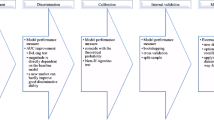Abstract
Prognosis aims at estimating the future course of a given disease in probabilistic terms. As in diagnosis, where clinicians are interested in knowing the accuracy of a new test to identify patients affected by a given disease, in prognosis they wish to accurately identify patients at risk of a future event conditional to one or more prognostic factors. Thus, accurate risk predictions play a primary role in all fields of clinical medicine and in geriatrics as well because they can help clinicians to tailor the intensity of a treatment and to schedule clinical surveillance according to the risk of the concerned patient. Statistical methods able to evaluate the prognostic accuracy of a risk score demand the assessment of discrimination (the Harrell’s C-index), calibration (Hosmer–May test) and risk reclassification abilities (IDI, an index of risk reclassification) of the same risk prediction rule whereas, in spite of the popular belief that traditional statistical techniques providing relative measures of effect (such as the hazard ratio derived by Cox regression analysis or the odds ratio obtained by logistic regression analysis) could be per se enough to assess the prognostic value of a biomarker or of a risk score. In this paper we provide a brief theoretical background of each statistical test and a practical approach to the issue. For didactic purposes, in the paper we also provide a dataset (n = 40) to allow the reader to train in the application of the proposed statistical methods.


Similar content being viewed by others
Availability of data and material
Data are provided in supplementary material.
References
Harrell FE Jr, Lee KL, Mark DB (1996) Multivariable prognostic models: issues in developing models, evaluating assumptions and adequacy, and measuring and reducing errors. Stat Med 15:361–387
Crowson CS, Atkinson EJ, Therneau TM (2016) Assessing calibration of prognostic risk scores. Stat Methods Med Res 25:1692–1706
Pencina MJ, D'Agostino RB Jr, D'Agostino RB Jr et al (2008) Evaluating the added predictive ability of a new marker: from area under the ROC curve to reclassification and beyond. Stat Med 27:157–172
Kerkmeijer LG, Monninkhof EM, van Oort IM et al (2016) PREDICT: model for prediction of survival in localized prostate cancer. World J Urol 34:789–795
Schmoor C, Sauerbrei W, Schumacher M (2000) Sample size considerations for the evaluation of prognostic factors in survival analysis. Stat Med 19:441–452
Ash D, Flynn A, Battermann J et al (2000) ESTRO/EAU/EORTC recommendations on permanent seed implantation for localized prostate cancer. Radiother Oncol 57:315–321
Tripepi G, Heinze G, Jager KJ et al (2013) Risk prediction models. Nephrol Dial Transplant 28:1975–1980
Funding
No Author has to disclose any conflict of interest that could have direct or potential influence or impart bias on the work.
Author information
Authors and Affiliations
Contributions
GD, CT, SR, GT contributed to the study conception and design. The first draft of the manuscript was written by GD, CT, SR, GT. MG AP critically revised the manuscript and provided important intellectual contribution. All authors read and approved the final version of the manuscript.
Corresponding author
Ethics declarations
Conflict of interest
On behalf of all authors, the corresponding author states that there is no conflict of interest.
Human and animal rights statement
This article does not contain any studies with human participants or animals performed by any of the authors.
Consent to participate
For this type of study formal consent is not required.
Consent for publication
Not applicable.
Code availability
Not applicable.
Additional information
Publisher's Note
Springer Nature remains neutral with regard to jurisdictional claims in published maps and institutional affiliations.
Electronic supplementary material
Below is the link to the electronic supplementary material.
Rights and permissions
About this article
Cite this article
D’Arrigo, G., Gori, M., Pitino, A. et al. Statistical methods to assess the prognostic value of risk prediction rules in clinical research. Aging Clin Exp Res 33, 279–283 (2021). https://doi.org/10.1007/s40520-020-01542-y
Received:
Accepted:
Published:
Issue Date:
DOI: https://doi.org/10.1007/s40520-020-01542-y




